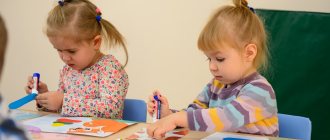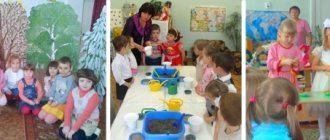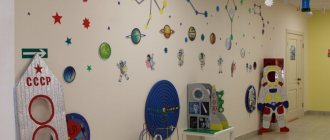MAGAZINE Preschooler.RF
Summary of an integrated educational activity for familiarization with the subject environment in the senior group “In the world of metal”Author: teacher Olga Nikolaevna Kozachkova p. Oktyabrsky of the Udmurt Republic
Goal: to develop children’s ideas about the properties of metal
Tasks:
Educational:
- Expand children's knowledge about metal, its qualities and properties through experimental activities.
- Enrich children's speech with verbs and adjectives that characterize the properties and qualities of metal (smooth, cold, hard, durable, heavy, can be attracted by a magnet).
- To develop the ability, with the help of an adult, to record acquired knowledge in the form of graphic drawings and diagrams on a research sheet.
- Develop the ability to talk using an algorithm about the properties of metal using your research sheet.
Educational:
- Develop cognitive and research interest by engaging in simple experiments with metal.
- Continue to develop logical thinking, memory, attention, observation.
- Develop the ability to make assumptions and conclusions.
- Continue to develop motor skills through physical exercise.
Educational:
- Nurture children's curiosity and independence.
- Cultivate the desire to finish what you start.
- Continue to develop the ability to listen to your interlocutor.
PRELIMINARY WORK: watch the video “How is metal mined and made?” ; games - experiments “What is what?” , examination of dishes made of various metals (cast iron, aluminum, iron).
MATERIALS AND EQUIPMENT: a robot decorated with LEDs, portable speakers - 2 pieces, a large travel map, explorer hats, a large cube, metal objects, one for each child: sticks, metal plates, coins, spoons, aluminum door handles, paper clips. Also for each child are magnetic rods, glass pebbles, a tray, glass and plastic glasses, simple pencils, research sheets for recording results, magnetic robots, and an “Expert” .
INTEGRATION OF EDUCATIONAL AREAS: “Physical development” , “Artistic and aesthetic development” , “Cognitive development” , “Speech development” .
NODE STROKE:
Introductory part.
Educator: Good morning guys, I’m very glad to see you! May this morning bring you joy and many new discoveries!
Game - greeting “My friend” (creating a psychological mood in class)
All the children gathered in a circle, I am your friend and you are my friend, Let’s hold hands together And smile at each other And say: “Good morning!”
Didactic game "Cube" (knowledge updating).
- Guys, look how many objects surround us in the group, and they are all made of different materials. Now I propose to remember what materials we know and what is made from them. Let's play the game "Funny Cube" . We pass the cube around with the words: “You roll the funny cube, quickly, quickly through your hands, whoever has the cube left will quickly tell us: tell us what is made from the material that fell out on the cube (for example: “This is a tree - they make it from tables, chairs, pencils).
Children play together with the teacher
Surprise "Robot" (music coming from behind the door).
Educator: guys, can you hear that? Some strange sound comes from behind the door (the teacher looks behind the door).
— Guys, an unusual guest came to visit us today. Want to know who it is? Then guess the riddle:
Children all over the world know that he is a smart machine. The nose is a light bulb, inside there are nuts. It has a rectangular head, and is almost alive like us. He has a lot of worries and of course this... (ROBOT)
Children guess the riddle (the teacher brings the robot into the group)
Main part.
The teacher brings the Robot into the group
Robot (the sound comes from a portable speaker that is located inside the robot) hello guys, I came to you for help. I was caught in a snowfall and because of this I lost my knowledge. Now I don’t know anything about myself. Can you tell me about what material I'm made of?
(children's answers)
What properties does metal have?
Educator: guys, let's help the robot learn a lot of interesting things about himself?! (children's answers)
Educator: How can we find out the properties of a metal?
(possible answers for children - conduct experiments, ask an adult, watch a program, think for yourself, read in a book...) I praise the children for their answers.
Educator: Where are experiments and research carried out?
(possible children's answers - in the laboratory)
Educator: And today we will set up a laboratory on the island of Metal, and Professor Pochemuchkin’s map and magic words will help us with this. Are you ready to say them? (the teacher unfolds the map, shows the island on the map, the children do the exercise together with the teacher).
Kinesiological exercise “To the island” :
“We’ll get to the island, we’ll explore everything, we’ll understand,
Let the scientists know, we will replace them."
Then take a seat at the tables.
Educator: Here we are in the laboratory (the children sit at the tables, put on medical caps, the teacher also wears a white coat. I watch my posture). But before we get down to business, let’s remember the safety rules in the laboratory (I show pictures on the easel).
Children name the rules of the laboratory. I praise the children for their answers.
Experiment No. 1: “Metal is smooth
Educator: Look, in front of you are various objects and research sheets for recording new knowledge.
Educator: Guys, what do you think, is metal smooth or rough? How can you find out? (children's assumptions).
Let's check? (children perform actions). How do you feel when you stroke metal with your finger? (children's answers). What conclusion can be drawn?
Children's answers.
Educator: So, we learned the first property - metal is smooth.
Experiment No. 2: . ”
Educator: Guys, what do you think will happen to a metal stick if you try to break it? (children's assumptions). Let's check! (children perform the action). What can we say? What conclusion can be drawn? (The stick does not break, which means the metal is strong and hard.)
Children's answers.
Educator: We learned the second property - metal
solid and durable.
I praise the children for their answers. I propose to write down the result of the experiment on a piece of paper.
Educator: Let's take our research sheet and sketch out new knowledge (children, using graphic images and diagrams, sketch the property of the metal in the first cell of the research sheet).
I choose the best option and suggest sketching it on the board.
Physical education lesson: “Move like a robot”
Educator: I suggest you rest a little. The robot has prepared a fun workout for us.
Children, together with the teacher, perform movements to the music.
Educator: Well done! I suggest returning to the laboratory, to another table.
Experiment No. 3: “Heavy metal” .
Educator: Do you think metal sinks in water? How can you check this? (children's assumptions). Shall we check? (take a metal part from the construction set and lower it into a container of water). What happened to her? (Children's answers.)
Educator: Why did the metal part drown? What conclusion can be drawn? (Children's answers.)
Educator: So, we learned another property of metal - metal is heavy, so it sinks in water.
I praise the children for their answers. I propose to write down the result of the experiment on a piece of paper.
Educator: Let's take our research sheet and sketch out new knowledge (children, using graphic images and diagrams, sketch the property of the metal in the first cell of the research sheet).
Educator: I sketch it on the board. I praise the children.
Experiment 4. “Metal is attracted by a magnet”
Educator: on your tray you have a variety of objects made from different materials. What kind of objects do you think a magnet can attract? How can I check this? (children's assumptions) (children use a magnet to determine which objects are metal).
Let's check your assumptions, lower the magnetic rod into the plates, tell me what the magnet attracted to itself?
(Children's answers are paper clips.)
-What do you think paper clips are made of?
(Children's answers: made of metal.)
What conclusion can be drawn? (Children's answers.)
Educator: We learned the fourth property of metal - it is attracted by magnets.
I praise the children for their answers. I propose to write down the result of the experiment on a piece of paper.
Educator: Let's take our research sheet and sketch out new knowledge (children, using graphic images and diagrams, sketch the property of the metal in the first cell of the research sheet).
Educator: I sketch it on the board. I praise the children.
Educator: Thank you guys, I really enjoyed working with you in our laboratory. People, knowing the properties of metal, take them into account when making various objects. We have conducted many experiments and what can we tell the Robot about it and about the properties of the metal from which it consists according to our research sheets (reading the mnemonic table). Let's choose by counting:
The robot does exercises and counts in order
One - the contacts do not spark, two - the joints do not creak,
Three – the lens is transparent, the robot is cheerful and beautiful.
One, two, three, four five, we can get down to business.
D/d defense of the research “Tell me according to the algorithm”
Defense of the research. At the end of the defense, the child pastes the “Expert” onto a large card.
Educator: Now it’s time for us to return from the laboratory. Let's say the magic words together.
Kinesiological exercise “We have gained knowledge”
Children: The secret of the island was revealed, we gained knowledge,
It's time for us to return, here's a scientific game!
Final part.
Surprise moment "Fixing the robot"
Robot: (sound is played from a speaker located inside the robot). Oh, you guys are great researchers, I learned a lot of interesting things about myself, you filled me with knowledge!!! Thank you! (the robot began to shine in different colors).
Educator: Guys, a Robot came to us today, what happened to him? What did we do to help the robot? What interesting things can we tell the children from the group and their parents?!
Educator: Well done, guys, Praise for every child.
Educator: Would you like to know if a magnet can attract metal objects through glass, plastic, wood, fabric? (children's answers). We will definitely find out about this next time.
Today, for your efforts, the Robot gives you this magnetic Robot, with its help you can explore and find objects made of metal.
| Next > |




